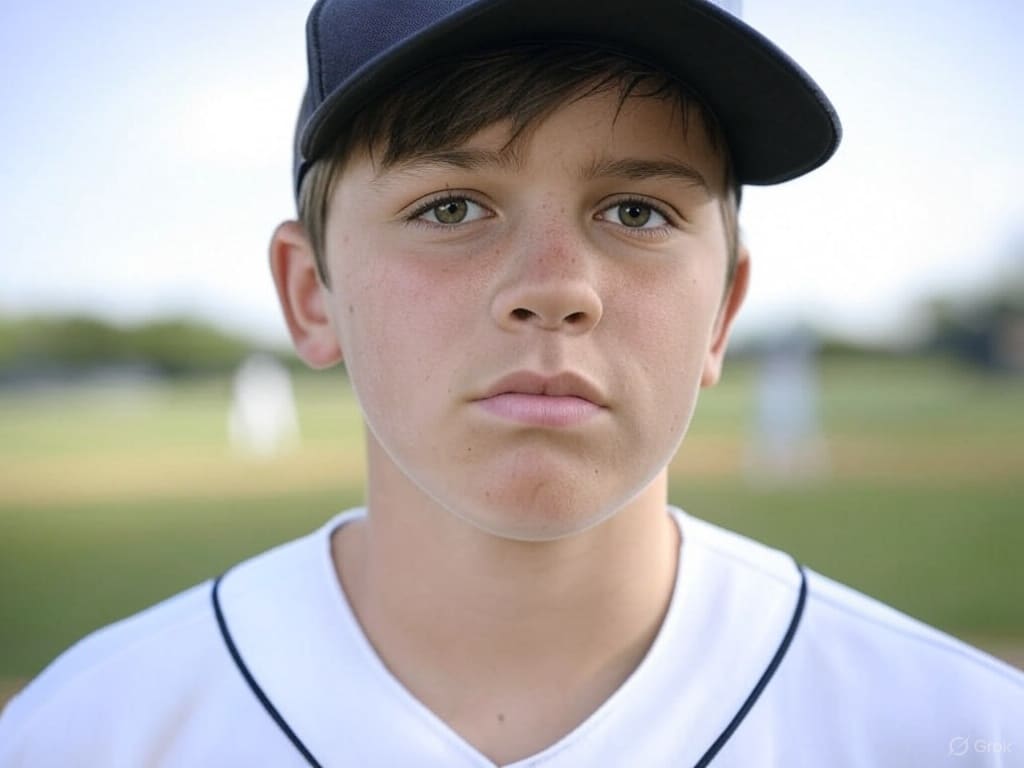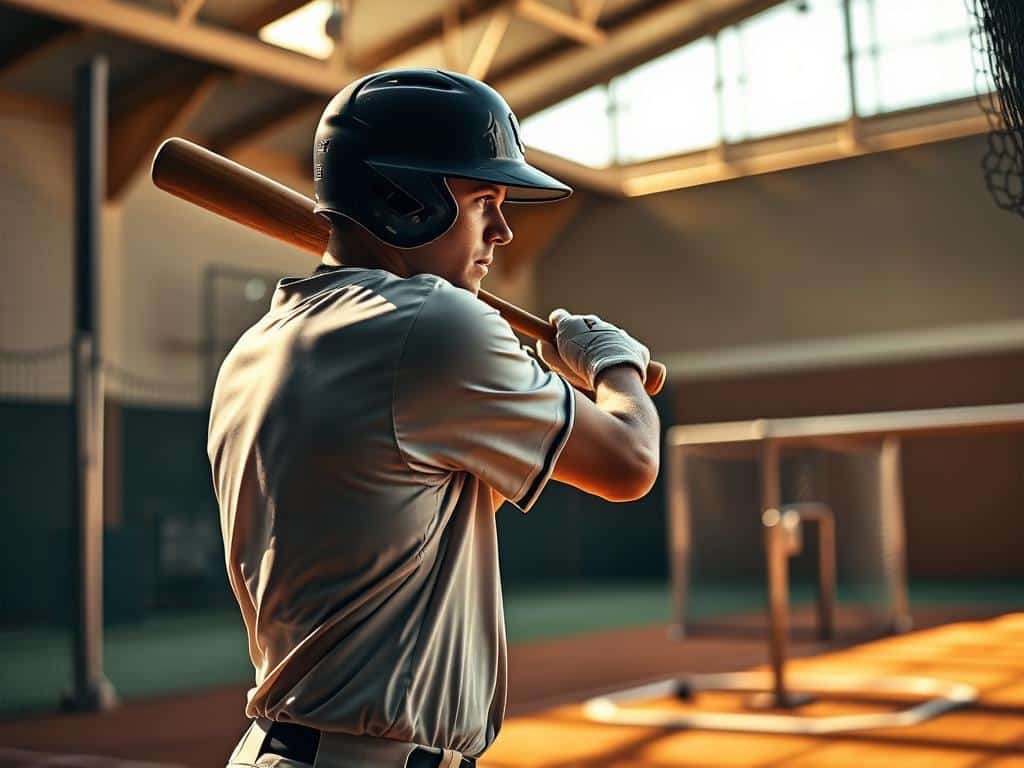
Slow Swings Start in the Mind—Hack Your Brain for Instant Bat Speed
Did you know that hesitation at the plate can cost hitters up to 20% of their potential bat speed? That’s the difference between a line drive and a weak grounder. As a coach, I’ve seen countless players freeze in critical moments, unsure whether to swing or take. But here’s the good news: verbal triggers can transform that hesitation into explosive action.
Verbal triggers are simple, powerful cues that help hitters react instinctively. Instead of overthinking, they trust their training and let their body take over. This approach shifts the mindset from “Fisherman” (waiting for the perfect pitch) to “Hunter” (attacking the zone with confidence). It’s not just about swinging—it’s about swinging with purpose.
Research from TheReadyState.com shows that mental cues can improve reaction time by up to 15%. That’s why I teach my players to use phrases like “attack” or “drive” to stay locked in. These triggers create a direct link between the mind and the body, eliminating doubt and maximizing performance.
Ready to see the results? Let’s dive into the science behind these techniques and how you can apply them in your next game or practice. Trust me, the difference will be undeniable.
Key Takeaways
- Verbal triggers eliminate hesitation and boost bat speed.
- Shift from a “Fisherman” to a “Hunter” mindset for better results.
- Mental cues improve reaction time by up to 15%.
- Use phrases like “attack” or “drive” to stay focused.
- Backed by research from TheReadyState.com and GMB.io.
Understanding the Mental Hurdle at the Plate
Hesitation at the plate is a silent killer of performance. It’s not just about missing a pitch—it’s about losing confidence and momentum. When a hitter over analyzes, their reaction time slows, and their swing loses its edge.
Identifying Swing Hesitation and Its Impact
Swing hesitation occurs when a player second-guesses their decision to swing. This delay can reduce bat speed by up to 20%, turning a potential line drive into a weak grounder. Elite hitters like Starling Marte have shown that aggressive swings yield better results, but hesitation can derail even the most skilled players.
Overthinking at the plate often leads to missed opportunities. For example, in an 0-2 count, the pressure to avoid a strikeout can cause hitters to freeze. This mental block prevents them from capitalizing on hittable pitches.
The Role of the Unconscious Mind in Hitting
The unconscious mind processes visual and timing cues faster than the conscious mind. This is why relying on instinct often leads to better results. Drills that train the unconscious mind, like focusing on a specific zone, can help hitters react more quickly.
For instance, narrowing the focus to an 8-inch zone instead of the entire plate can simplify decision-making. This approach helps hitters like Marte stay aggressive and ready to attack the pitch they want.
| Mental Hurdle |
Impact |
Solution |
| Overthinking |
Slows reaction time |
Focus on a specific zone |
| Hesitation |
Reduces bat speed |
Trust instincts |
| Fear of failure |
Leads to conservative play |
Embrace aggressive mindset |
Eliminating doubt is key to unlocking aggressive swing mechanics. By training the mind to trust the body, hitters can turn mental hurdles into competitive advantages. Ready to explore mindset shifts? Let’s dive deeper into proactive strategies.
Boost Your Child’s Hitting Confidence & Power—Fast!
Give your young hitter an edge at the plate with proven drills designed to build explosive power, consistency, and confidence. Get instant access to 4 expert-crafted hitting guides—free for a limited time!
Get Your FREE Hitting Guides Now
Embracing a Proactive Mindset: The Hunter vs. The Fisherman
Baseball is a game of split-second decisions, and your mindset can make or break your performance. At the plate, you’re either a Hunter or a Fisherman. The Hunter attacks with confidence, while the Fisherman waits for the perfect opportunity. Both approaches have their merits, but knowing when to use each is the key to unlocking your full potential.
The Hunter Mindset: Striking Fast When in the Zone
The Hunter mindset is all about aggression. When the pitcher is in the zone, the Hunter doesn’t hesitate. They trust their instincts and swing with purpose. Vlad Guerrero, one of the most aggressive hitters in MLB history, epitomized this approach. He rarely walked but consistently made contact, often turning borderline pitches into base hits.
This mindset thrives on quick reactions. A player has less than a quarter of a second to decide whether to swing, and the Hunter trusts their unconscious mind to make the right call. By focusing on a specific zone, they eliminate doubt and maximize their chances of success.
The Fisherman Mindset: Patience and Plate Discipline
On the other hand, the Fisherman waits for the perfect pitch. Barry Bonds, one of the greatest hitters of all time, mastered this approach. From 2001 to 2004, he walked an average of 188 times per year while hitting 52 home runs annually. His patience at the plate allowed him to capitalize on mistakes and avoid strikeouts.
The Fisherman mindset emphasizes discipline. Instead of swinging at every pitch, they wait for one in their preferred zone. This approach requires a deep understanding of the strike zone and the ability to recognize pitches early.
| Mindset |
Key Traits |
Player Example |
| Hunter |
Aggressive, instinctive, quick reactions |
Vlad Guerrero |
| Fisherman |
Patient, disciplined, selective |
Barry Bonds |
Neither mindset is inherently superior. The Hunter thrives in high-pressure situations (and pitchers in the zone), while the Fisherman excels in controlling the game’s pace (and pitchers around the zone). The key is to recognize which approach fits the moment and adapt accordingly. Mental training helps hitters strike the right balance between aggression and patience, unlocking their full potential at the plate.
Leveraging Proven Verbal Triggers for Instant Action
What if I told you a single word could unlock explosive bat speed? Verbal triggers are the secret weapon every coach needs to eliminate hesitation and ignite action at the plate. These cues rewire the hitter’s instincts, turning doubt into confidence and hesitation into aggression.
Research shows that mental hitting drills can reduce reaction time by up to 15%. By using phrases like “stop deciding” or “hit the first pitch,” you can train your players to act instinctively. This approach eliminates the internal decision-making process, leading to faster swings and better results.
Simple Cues to Eliminate Doubt at the Plate
Verbal triggers like “see the ball and hit it hard” force the hitter to commit before the pitch arrives. These cues simplify the process, allowing the player to focus on the zone rather than overthinking. The result? Increased bat speed and consistent contact.
For example, during practice, I encourage my hitters to repeat phrases like “attack the zone” or “drive the ball.” These words create a direct link between the mind and the body, turning hesitation into action. It’s not just about swinging—it’s about swinging with purpose.
Building Confidence Through Repetition and Drill Routines
Confidence comes from repetition. By integrating verbal triggers into every drill, you can build automatic responses in your hitters. Start with simple routines like focusing on a specific zone or hitting the first pitch. Over time, these habits become second nature.
Consistency is key. Use these cues in every practice and game scenario to reinforce the mindset. The more your players hear these phrases, the more ingrained they become. This approach not only improves performance but also prepares them for high-pressure moments.
Ready to transform your team? Start incorporating verbal triggers today and watch the difference unfold. The results will speak for themselves!
This is a video in the Swing Shift series…
Boost your hitting skills with Swing Shift’s science-backed practice system! This program is packed with features to improve hand path stability, timing, and power. Enjoy engaging drills for consistent progress and fun challenges to keep training exciting. Swing Shift is designed to help players succeed at every level.
The Swing Shift platform lets you focus on key mechanics like bat angle, balance, and hand path control. Dive into step-by-step video lessons that cover power, contact, and rhythm, breaking down the science behind a great swing. With personalized feedback and progress tracking, you can refine your technique and watch your results improve.
Whether you’re a youth athlete, high school player, or elite hitter, Swing Shift is trusted by families and coaches everywhere. Master core skills like bat control, weight transfer, and rotational power with drills designed for real game results. Start your journey to hitting greatness with Swing Shift!
Swing Shift’s practice system offers a wide range of tools to elevate your hitting:
- RNT-based drills for real-time correction
- Engaging challenges for competitive practice
- Personalized training goals and skill progression
- Exclusive videos on timing, power, and consistency
- Hands-on feedback to track and improve your swing mechanics
- Trusted by dedicated parents, players, and coaches
Reach your full potential with Swing Shift’s comprehensive practice system. Elevate your hitting with cutting-edge techniques and proven, science-based training.
Boost Your Child’s Hitting Confidence & Power—Fast!
Give your young hitter an edge at the plate with proven drills designed to build explosive power, consistency, and confidence. Get instant access to 4 expert-crafted hitting guides—free for a limited time!
Get Your FREE Hitting Guides Now
How to Swing Aggressively: Techniques and Drills
Aggressive swings don’t happen by accident—they’re built through deliberate practice. To unlock explosive bat speed, you need the right mindset, mechanics, and drills. Let’s dive into proven techniques that eliminate hesitation and maximize performance at the plate.
Hitting the First Pitch: Eliminating Decision Paralysis
Committing to the first pitch is a game-changer. Many hitters freeze, waiting for the “perfect” pitch, but this hesitation costs them opportunities. By focusing on the strike zone and trusting your instincts, you can turn the first pitch into a powerful hit.
Drills leading to the Catapult Loading System enhance muscle memory for an optimal launch position. This ensures you’re ready to attack the first pitch with confidence. Remember, the goal is to swing with purpose, not hesitation.
Integrating Vision and Timing Drills into Practice
Vision and timing are critical for aggressive swings. Major League Baseball teams have integrated vision training into player development since 2015, and the results are undeniable. Drills like the Flamingo Float Drill focus on balance, bat control, and lower half rotation, ensuring you’re in sync with the pitch.
Another effective drill is the swing across your face drill, which makes sure hitters are swinging with rotational purpose. These exercises build the foundation for consistent, powerful contact.
Maximizing Bat Speed with Focused Training
Bat speed is the key to driving the ball deep into the outfield. The Catapult Loading System creates a proper load and launch position, critical for generating power. By focusing on loading the spine, you can maximize your swing’s potential.
Simulating game scenarios during practice is also essential. For example, ahead in the count drills encourage hitters to visualize hitting the ball with backspin into the outfield gaps. This prepares you for high-pressure moments and ensures you’re ready to perform when it counts.
Ready to take your swing to the next level? Check out our training videos for immediate skill improvement. The results will speak for themselves!
Integrating Swing Strategies into Practice and Game Scenarios
Transforming hesitant hitters into confident performers starts with structured practice and real-game application. It’s not enough to teach theory—players need to experience these strategies in action. By integrating mental and physical cues into every session, you can bridge the gap between practice and performance.
Coaching Youth Hitters: Turning Theory into Results
Youth hitters often struggle with hesitation at the plate. The key is to simplify their approach. Start by focusing on a specific zone, like the 8-inch middle area, to build confidence. Use verbal triggers like “attack the ball” to eliminate doubt and encourage aggressive swings.
Incorporate drills like the “18 outs” drill, which involves the starting 9 players and resets the count to 0 after each error. This simulates real-game pressure and helps players stay focused. Consistency is crucial—repeat these drills until they become second nature.
Applying Mental and Physical Cues in Real Game Situations
Game day is where theory meets reality. Encourage players to trust their instincts and focus on the zone they’ve practiced. For example, if a hitter has been working on driving the ball into the gaps, remind them to “see it and hit it hard” during the game.
Adjust verbal cues based on the situation. In an 0-2 count, phrases like “stay aggressive” can help players avoid freezing. The goal is to create a mindset where hesitation is replaced by action.
For more advanced techniques, check out our youth hitting drills. These resources provide structured training to help players unlock their full potential.
Conclusion
Success at the plate isn’t just about physical skill—it’s a mental game. From understanding hesitation to mastering aggressive swings, the journey requires both mindset shifts and actionable drills. Verbal triggers like “attack the zone” and the Hunter vs. Fisherman approach are game-changers, eliminating doubt and boosting confidence.
Key drills, such as focusing on a specific zone or hitting the first pitch, drive immediate performance enhancements. These techniques are backed by science, ensuring consistent success. Whether you’re a coach or player, integrating these strategies into practice and live game situations is essential.
Ready to transform your performance? Start today and see the difference. For more advanced techniques, explore our aggressive mindset resources. Share your progress and reply to hesitation with action—your results will speak for themselves!
Boost Your Child’s Hitting Confidence & Power—Fast!
Give your young hitter an edge at the plate with proven drills designed to build explosive power, consistency, and confidence. Get instant access to 4 expert-crafted hitting guides—free for a limited time!
Get Your FREE Hitting Guides Now
FAQ
What causes hesitation at the plate?
Hesitation often stems from overthinking or fear of failure. Your unconscious mind can slow reactions, making it harder to trust your instincts and swing confidently.
How does the Hunter mindset improve hitting?
The Hunter mindset focuses on attacking the pitch aggressively. It trains you to act decisively in the zone, eliminating doubt and boosting bat speed.
Can verbal triggers really help my swing?
Absolutely! Simple cues like “See it, hit it” or “Attack” can override hesitation. These triggers prime your mind and body for instant, aggressive action.
What drills improve bat speed and timing?
Vision drills, like tracking colored balls, and timing drills, such as hitting off a pitching machine, sharpen your focus and reaction time. Consistent practice maximizes results.
How do I apply these strategies in a game?
Start by practicing mental cues and drills during training. In games, trust your preparation and focus on one pitch at a time. Confidence comes from repetition!
What’s the best way to coach young hitters?
Break down complex concepts into simple steps. Use fun drills and positive reinforcement to build their confidence and aggressive mindset at the plate.





















